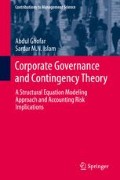Abstract
The purpose of this chapter is to present the results of the data analysis using the research method as explained in Chap. 4. This chapter is organized as follows. Firstly, Sect. 5.2 presents the descriptive analysis which includes the industry category of the samples and descriptive analysis of measures of constructs. Secondly, Sect. 5.3 presents the discussions of the measure of model fit. Section 5.4 discusses the discriminant validity. At this stage, the examination of single-factor congeneric model and confirmatory analysis is presented. Section 5.5 discusses the reliability of the constructs, while Sect. 5.6 provides the results of the full structural model. The last section (Sect. 5.7) summarizes the content of this chapter.
Access this chapter
Tax calculation will be finalised at checkout
Purchases are for personal use only
References
Aryani, Y. A. (2009). The Effect of fairness perception of performance measurement in the balanced scorecard environment. Doctor of Philosophy thesis, Victoria University.
Bentley, K. A., Omer, T. C., & Sharp, N. Y. (2012). Business strategy, audit effort, and financial reporting irregularities. Contemporary Accounting Research, 30, 780–817.
Blunch, N. J. (2008). Introduction to structural equation modeling using SPSS and AMOS (Vol. 1). London: Sage.
Bollen, K. A., & Stine, R. A. (1992). Bootstrapping goodness-of-fit measures in structural equation models. Sociological Methods and Research, 21, 205–229.
Draghici, S. (2012). Statistics and data analysis for microarrays using R and bioconductor (2nd ed.). Boca Raton, FL: CRC.
Eisenberg, T., Sundgren, S., & Wells, M. T. (1998). Larger board size and decreasing firm value in small firms. Journal of Financial Economics, 48(1), 35–54.
Fornell, C. (1983). Issues in the application of covariance structure analysis: A comment. The Journal of Consumer Research, 9(4), 443–448.
Gani, L., & Jermias, J. (2006). Investigating the effect of board Independence on performance across different strategies. The International Journal of Accounting, 41, 295–314.
Gefen, D., Straub, D., & Boudreau, M. C. (2000). Structural equation modeling and regression: Guidelines for research practice. Communications of the Association for Information Systems, 4, 1–77.
Gordon, L. A., Loeb, M. P., & Tseng, C. Y. (2009). Enterprise risk management and firm performance: A contingency perspective. Journal of Accounting & Public Policy, 28, 301–327.
Hair, J. F., Anderson, R. E., Tatahm, R. L., & Black, W. C. (2010). Multivariate data analysis (7th ed.). Upper Saddle River, NJ: Prentice-Hall International.
Holmes, S., Cunningham, E., & Coote, L. (2006). Structural equation modeling: From the fundamentals to advanced topics. Melbourne: Sream and Statsline.
Holmes-Smith, P. (2012). Structural equation modeling (using AMOS): From the fundamentals to advanced topics. Melbourne: School Research Evaluation and Measurement Services (SREAMS).
Hu, L., & Bentler, P. M. (1999). Cutoff criteria for fit indexes in covariance structure analysis: Conventional criteria versus new alternatives. Structural Equation Modeling: A Multidisciplinary Journal, 6(1), 1–55.
Krishnan, G. (2003). Audit quality and the pricing of discretionary accruals. Auditing: A Journal of Practice & Theory, 22(1), 109–126.
Larcker, D. F., Richardson, S. A., & Tuna, I. (2007). Corporate governance, accounting outcomes, and organizational performance. The Accounting Review, 82(4), 963–1008.
Naiker, V., Navissi, F., & Sridharan, V. (2009). The agency cost effects of unionization on firm value. Journal of Management Accounting Research, 20, 133–152.
Nazari, J. A. (2010). An investigation of the relationship between the intellectual capital components and firm’s financial performance. Doctor of Philosophy thesis, University of Calgary.
Rahman, M. Z. (1998). The role of accounting in the East Asian financial crisis: Lessons learned. Transnational Corporations, 7(3), 1–52.
Reddy, S. K. (1992). Effects of ignoring correlated measurement error in structural equation models. Educational and Psychological Measurement, 52(3), 549–570.
Wibowo, A. (2008). The impact of organizational culture and internal corporate governance on organizational performance in Indonesian Companies. Doctor of Philosophy thesis, Curtin University of Technology.
Wolfle, L. M., & Ethington, C. A. (1986). Within-variable, between occasion error covariances in models of educational achievement. Educational and Psychological Measurement, 46(3), 571–583.
World Bank. (2010). The 2010 corporate governance ROSC for Indonesia. Washington, DC: World Bank.
Yatim, P. (2009). Board structures and the establishment of a risk management committee by Malaysian listed firms. Journal of Management and Governance, 14, 17–36.
Zhang, Y., Zhou, J., & Zhou, N. (2007). Audit committee quality, Auditor independence, and internal control weaknesses. Journal of Accounting and Public Policy, 26, 300–327.
Spira, L. F., & Page, M. (2003). Risk management: The reinvention of internal control and the changing role of internal audit. Accounting Auditing & Accountability, 16(4), 640–661.
Fornell, C., & Bookstein, F. L. (1982). Two structural equation models: LISREL and PLS applied to consumer exit-voice theory. Journal of Marketing Research, 19, 440–452.
Author information
Authors and Affiliations
Rights and permissions
Copyright information
© 2015 Springer International Publishing Switzerland
About this chapter
Cite this chapter
Ghofar, A., Islam, S.M.N. (2015). Results. In: Corporate Governance and Contingency Theory. Contributions to Management Science. Springer, Cham. https://doi.org/10.1007/978-3-319-10996-1_5
Download citation
DOI: https://doi.org/10.1007/978-3-319-10996-1_5
Published:
Publisher Name: Springer, Cham
Print ISBN: 978-3-319-10995-4
Online ISBN: 978-3-319-10996-1
eBook Packages: Business and EconomicsBusiness and Management (R0)

